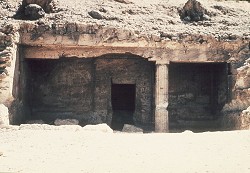
Der name eines Ortes am Ostufer des Nils etwa 23 km nördlich von Minieh. Der Platz ist nach einem dort lebenden arabischen Stamm benannt. Die bedeutendsten Denkmäler sind neununddreißig Felsgräber, die hauptsächlich in die 11. und 12. Dynastie datieren; einige wenige Gräber datieren in die 6. Dynastie. Viele der Gräber gehören den Gaufürsten des betreffenden Gaues, des Oryxgaues; davon sind zwölf dekoriert. Wegen der schlechten Qualität des Steines wurde zuerst eine Stuckschicht angebracht, auf die die Wandmalereien gemalt wurden. Eine bakannte Szene zeigt siebenunddreißig Asiaten, die schwarze Augenschminke bringen. Man hat dies mit dem Einzug der Kinder Israel nach Ägypten in Verbindung gebracht, um so mehr, als einer der Männer Abischar heißt, ein Name, der auch in der Bibel vorkommt. Andere Wandmalereien zeigen die Jagd in der Wüste, Sport und Spiel, detaillierte Szenen aus dem Leben der Tiere sowie die üblichen Szenen. Im Hang vor den Felsgräbern befinden sich Hunderte von einfacheren Gräbern vor allem aus dem Mittleren Reich. In ihnen wurden viele dekorierte Särge und Grabmodelle gefunden. In der Nähe gibt es einen Felstempel aus dem Neuen Reich, der der Löwengöttin Pachet geweiht ist; daneben ist ein Friedhof für Katzenmumien. Weiterhin gibt es andere Gräber aus beinahe jeder Epoche außer dem Neuen Reich.